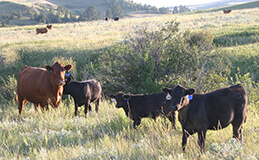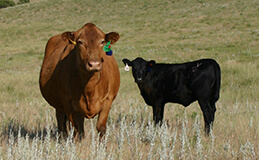F-1 Cross and Hybrid Vigor
The most obvious benefit of any F-1 cross of beef cattle is the roughly 12-14% increase in rate of gain available through hybrid vigor, with the second cross offering additional hybrid growth benefits. However, the South Devon F-1 cross offers even more.
The commercial beef cow of the future will be a combination of two or more breeds strong in maternal traits, early sexual maturity, high fertility, calving ease mothering and milking ability and an easy keeper with longevity and environmental adaptability. She must calve at two years of age, not be abnormally large and will probably be bred to a bull of a third compatible breed.
The South Devon is the "maternal breed" needed by the American beef industry for the superior F-1 beef cow. She will provide all of the above qualities with the increased frame to carry more pounds of beef, yet will not bring with her the calving or feed efficiency problems of some continental European breeds.
Lee Leachman, Leachman Cattle of Colorado, Wellington, Colorado noted that on the ranch, hybrid vigor is a key driver of profitability. Hybrid vigor increases fertility, cow longevity, calf survival and calf weight. When summed, these factors increase the pounds weaned per cow exposed by up to twenty three percent. On a ranch weaning an 85% calf crop with a 550 pound average weaning weight, this 23% advantage adds up to an extra 93.5 pounds of calves to sell per cow. Ranchers should crossbreed, but they need to crossbreed with a breed that works on the ranch and does not sacrifice the value of the calves produced. He went on to not that the challenge to crossbreeding is finding the right breed to cross on Angus. Most ranchers fondly recall the black baldy cows that they had in the 70’s. This leads them to first consider Hereford. While Hereford x Anugs females are great, the resulting F1 feeder calves leave much to be desired. The Hereford x Angus steer lacks Angus levels of marbling, has insufficient muscularity and does not reach adequate carcass weights before getting too fat. The South Devon breed keeps Angus marbling, adds to muscularity and increases carcass weight. For these reasons, South Devon is the best British breed crossbreeding option.
Jack Cowley, Cowley Ranch, Montague, California wanted to improve the efficiency of his Angus based cowherd. “I wanted to improve my consistency and keep the marbling we had in our cow herd. It was important to increase conception rates, which I knew we could do through crossbreeding. I wanted more docility in my herd as well. I also believe we need to enhance tenderness, which is a tough trait to measure commercially. I studied the US Meat Animal Research Center data and it showed South Devon to be the most tender beef breed.”
The Cowleys are just getting data that show the cattle are really working. “We just closed out another set of cattle through the Harris Ranch program. We had a 61 pound increase in weaning weight on the herd with the added South Devon influence – that is an age-adjusted figure, so it’s for real,” Jack points out. “We wanted to improve yield on the cattle and we saw an average Yield Grade of 3.08 on the Angus calves while the South Devon saw an improved average of 2.83, so we are definitely headed in the right direction.” “We needed a consistent sized rib eye and the South Devon crosses added right at ½” in rib eye size, boosting that to an average 12.3” compared to the Angus with an 11.8” average rib eye.”



